#eastern fashion clothing for men
Explore tagged Tumblr posts
Text
every single thing about medieval and renaissance era clothing only talks about englandfranceburgundyspaingermany. what were the serbs wearing???? what were the poles and the hungarians wearing??????
#i do know this a little bit and i have a pretty good idea of the male fashion and how it was inspired by byz and otts empires more than west#however my issue is there are so much fewer depictions of women that i have found from those countries and i can't tell if their clothing#was also eastern inspired or skewed more towards west? i mean i am kind of thinking that because that's what a lot of pictures show but als#I don't want to take pictures made by west euros into account because they're probably just drawing women in what they thought#their women wore. then again men often adopt foreign styles more than women pre renunciation#like crusader kingdoms men#plus whenever you try to research this stuff the national folk costumes of these countries come up and idk how that all fits in#considering that so much of those were more a product of 20th c nationalist movement than tradition
2 notes
·
View notes
Text
[餘知傳] The 2nd Century Warlord (Part 1)
based on the story by @romanceyourdemons
art by @its-not-a-pen
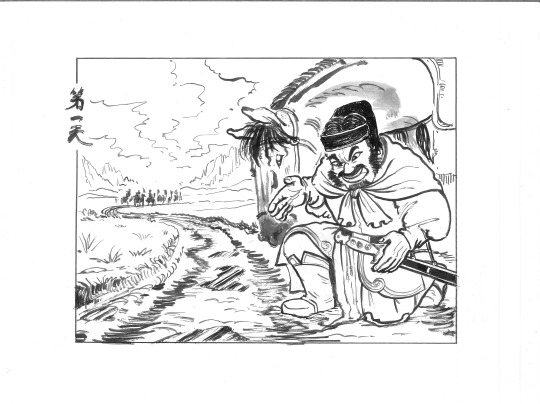
first day as a second century warlord i have my men tie branches to their horses’ tails to stir up dust and make it look like there’s a lot of us but i forget it just rained so there isn’t any dust and the enemy can clearly see there’s like twenty of us all spread out in a line

second day as a second century warlord i bribe a bunch of kids to start singing a nursery rhyme i carefully crafted to spread misinformation and further my strategic ends but they change the lyrics to be about poop and the enemy isn’t misdirected at all
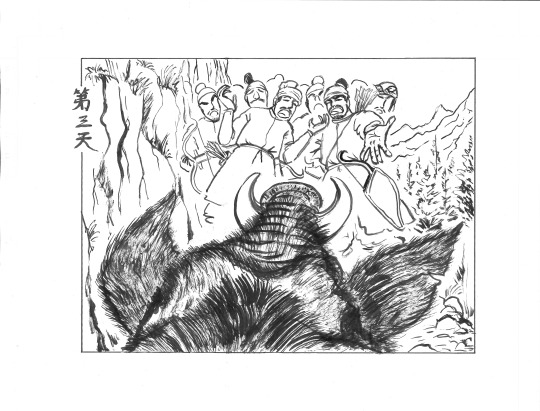
third day as a second century warlord i lure my enemy into a narrow valley and send a team of archers to shoot them from the high ground but there was a feral hog napping on the trail up to the overlook and they couldn’t decide whether to try and shoot it or just go around and by the time the hog woke up and left on its own the enemy had already passed safely below
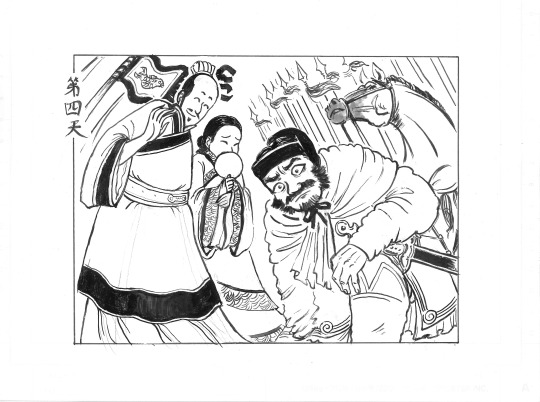
fourth day as a second century warlord we attempt to join a battle on the side of the guy we want to ally with but he and the guy he’s fighting have really similar names and it’s finally dusty and i misread the standards and attack the wrong guy. so now we’re stuck with this total loser of a liege lord, because how the fuck do you explain that after a battle?

fifth day as a second century warlord and some sort of wizard wanders into camp, my loser liege lord wants to execute him for being a wizard but i convince him to let the wizard stay, because i want to do more weather-based strategies and i’m pretty sure having a camp wizard can help with that. after the welcome to the team banquet the wizard steals half the treasury and my liege lord’s wife and leaves
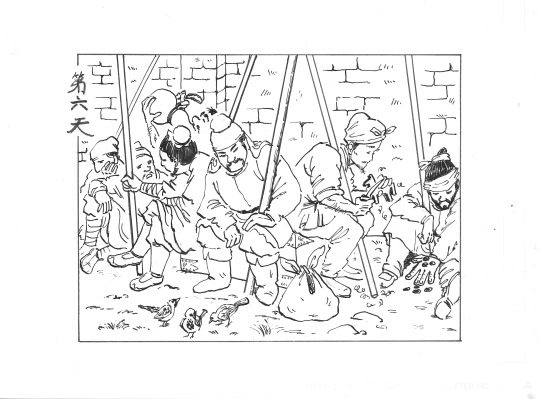
sixth day as a second century warlord my loser liege lord sends me to reinforce a city he’s taken, but in the confusion of leaving i forgot to take the token that would have gotten us into the city, so my men have to wait outside the city walls for like eight hours while i ride back to get it
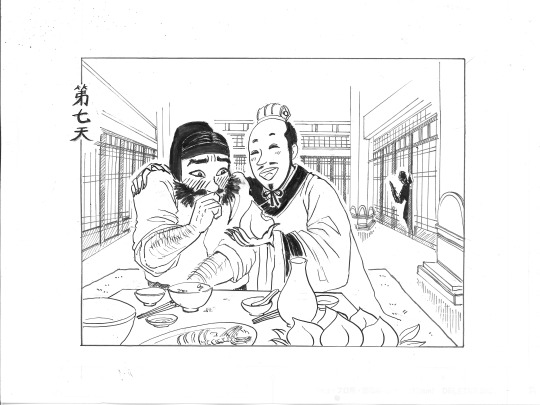
seventh day as a second century warlord and my loser liege lord finally joins me in the city, it turns out he’s actually a pretty cool guy, and he isn’t even that mad at me for letting the wizard steal his wife. i decide to shoot my shot but i’m really nervous and keep on stalling because what if i mess up our relationship and by extension jeopardize the security of my men, and eventually he just says goodnight and goes back to his room, where an assassin is in the process of setting up to kill him
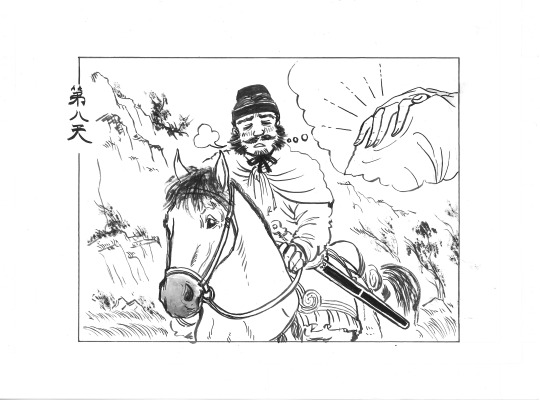
eighth day as a second century warlord and my loser liege lord tells me to fake defect to his rival warlord, the one i originally wanted to ally with, to find out if he was the one who sent the assassin and why. but my whole way over to the rival warlord i’m worried that this has something to do with the wizard thing or how awkward i made it last night
End of Part 1
part 2
This comic was made independently from the creator, I'm just a fan and these are my own interpretations.
Notes under the cut:
the title 餘知傳 [the Story of Yu Zhi], is the styled name of the Second Century Warlord. I translated 餘知 as [plentiful knowledge] since he's defined by a surplus of knowledge but a deficit in luck. It's also great for fish-based puns since it's a homophone. As a nice parallel, Loser Liege Lord's banner is a carp ;))). the art style was inspired by vintage Chinese comics.

The story is set during the Three Kingdoms period, (220 to 280 AD) natural disasters, infighting and civil unrest had dissolved the previous Han Dynasty, leading to a violent free-for-all. I based the clothes on the previous Eastern Han styles, mainly because there just weren't a lot of contemporary references from the 3K period (and it only lasted like, 60 years). I always strive for historical accuracy, however, the Han Dynasty was over 400 years long and some sources don't do a great job separating out the different fashions, so I apologise for any mistakes that occur.
2. there aren't a ton of drawings on what Han children looked like, but in general ancient kids hairstyles are pretty consistent. 9-15 yo boys had shaved heads with two little top knots, girls had natural hair in braids/buns.
3. the crossbow (back left) makes a cameo, it was associated with Zhuge Liang, famous real-life strategist from the 3K era.
4. the LLL and his wife thank the Warlord, (a noblewoman on a battlefield??? scandalous!). it shows the LLL enjoys the unconventional and the wife is not as timid as she appears. I thought it would be funny to make them look as Background Character (tm) as possible.
5. I based the wizard's design on sages from mythology. (Hey, he's not a total fraud, he invented gunpowder 800 years before the Tang dynasty!) Nice little character moment for the LLL who is shielding his wife.
6. What do soldiers do while they're waiting for 8 hours? (<-from the right) playing knucklebones with pebbles, whittling a little horse, feeding sparrows, gossiping with neighbour, drinking from his gourd, napping. A minor warlord can't afford to keep a professional army so they're most likely conscripted farmers who've had to buy their own weapons and armour, hence why they look so unimpressive.
7. LLL offers the Warlord a bitten peach. Inspired by the legend of Mizi Xia who bit into a delicious peach and gave it to the Emperor so he could taste it was well. "Bitten peach" was a byword for homosexuality in ancient China. I thought it would be SO funny if the LLL was actually smooth af and the Warlord was a like a teenaged girl crushing for the first time. He's desperate to taste that peach but is too timid to reach out >;))) man has zero game. negative game, even. truely the PS4 of homosexuals. RIP to the assassin in the back corner who was forced to watch the most awkward, cringe-fail attempt at flirting in the history of china play out.
8. this is what zero peach does to a mf. UnU
#ink drawing#comics#second century warlord#original art#ancient china#op if ur reading this im a huge fan and i love ur work#storytime#tumblr stories#history memes#romance of the three kingdoms
2K notes
·
View notes
Text
[Hanfu · 漢服]Chinese Late Warring States period(475–221 BC) Traditional Clothing Hanfu Based On Based On Chu (state)Historical Artifacts

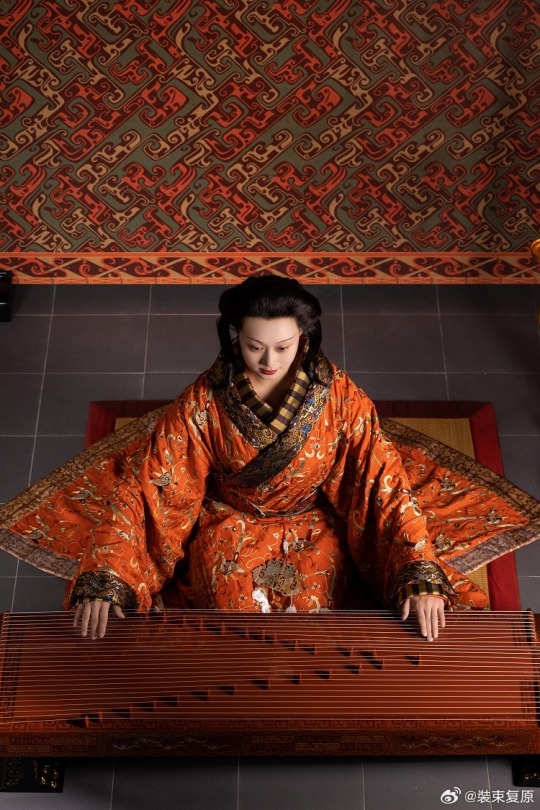

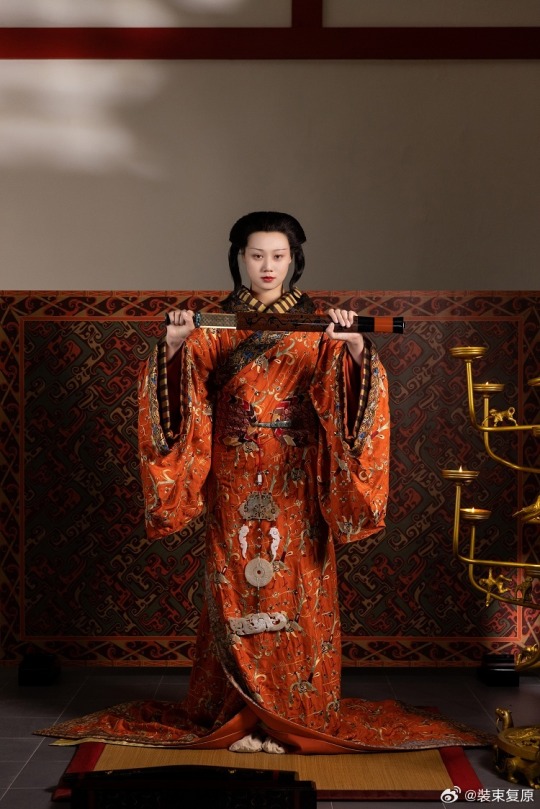
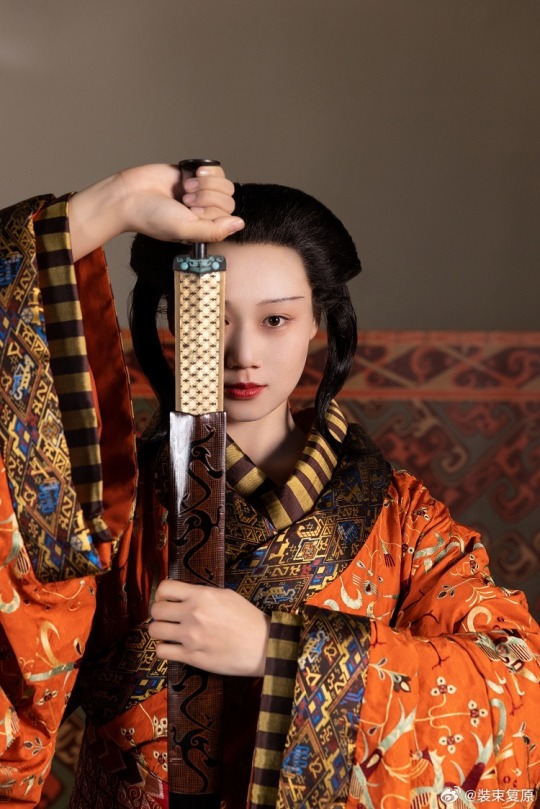
【Historical Artifact Reference】:
Late Warring States period(475–221 BC):Two conjoined jade dancers unearthed from Jincun, Luoyang,collected by Freer Museum of Art
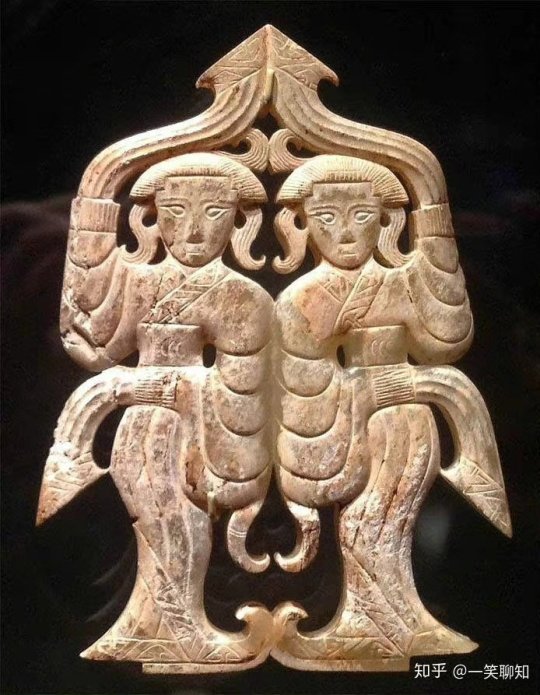
A similar jade dancer was also unearthed from the tomb of Haihunhou, the richest royal family member in the Han Dynasty, and was one of his treasures.
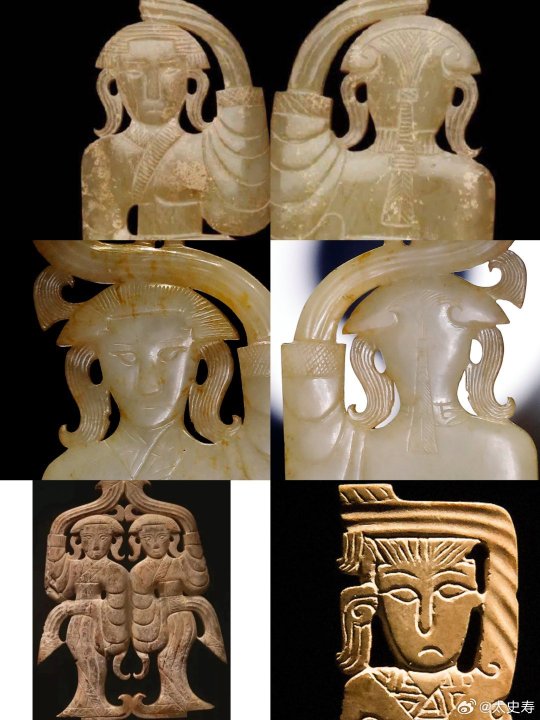
Warring States period, Eastern Zhou dynasty, 475-221 BCE,jade dancer by Freer Gallery of Art Collection.

Warring States period(475–221 BC)·Silver Head Figurine Bronze Lamp.Unearthed from the Wangcuo Tomb in Zhongshan state during the Warring States Period and collected by the Hebei Provincial Institute of Cultural Relics and Archaeology

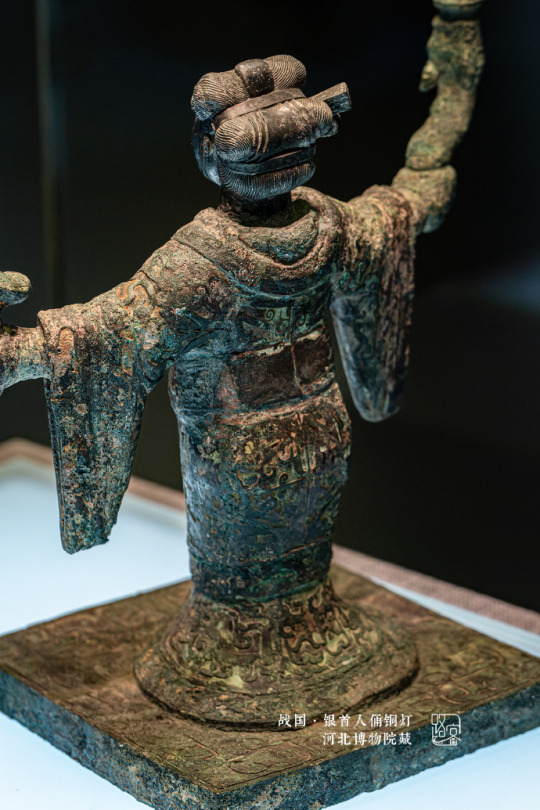
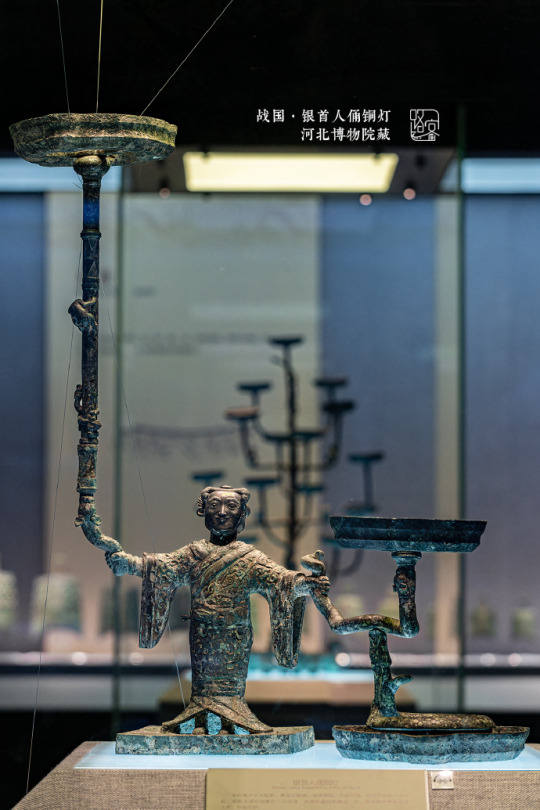
The figurine of a man dressed as a woman holds a snake in his hand, and 3 snakes correspond to 3 lamps.
Sword of Goujian/越王勾践剑:
The Sword of Goujian (Chinese: 越王勾践剑; pinyin: Yuèwáng Gōujiàn jiàn) is a tin bronze sword, renowned for its unusual sharpness, intricate design and resistance to tarnish rarely seen in artifacts of similar age. The sword is generally attributed to Goujian, one of the last kings of Yue during the Spring and Autumn period.
In 1965, the sword was found in an ancient tomb in Hubei. It is currently in the possession of the Hubei Provincial Museum.
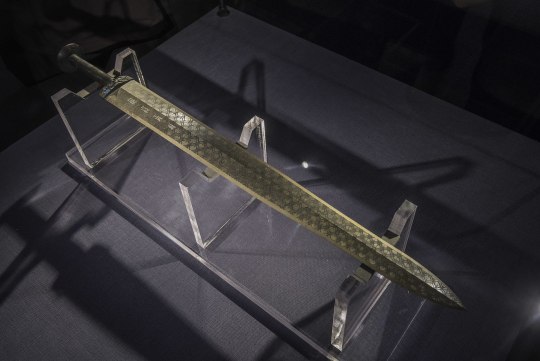
【Histoty Note】Late Warring States Period·Noble Women Fashion
The attire of noblewomen in the late Warring States period, as reconstructed in this collection, is based on a comprehensive examination of garments and textiles unearthed from the Chu Tomb No. 1 at Mashan, Jiangling, as well as other artifacts from the same period.
During the late Warring States period, both noble men and women favored wearing robes that were connected from top to bottom. These garments were predominantly made of gauze, silk, brocade, and satin, with silk edging. From the Chu Tomb No. 1 at Mashan, there were discoveries of robes entirely embroidered or embroidered fragments. The embroidery technique employed was known as "locked stitches," which gave the patterns a three-dimensional, lively appearance, rich in decoration.
The two reconstructed robes in this collection consist of an inner robe made of plain silk with striped silk edging, and an outer robe made of brocade, embroidered with phoenixes and floral patterns, with embroidered satin edging. Following the structural design of clothing found in the Mashan Chu Tomb, rectangular fabric pieces were inserted at the junction of the main body, sleeves, and lower garment of the robe. Additionally, an overlap was made at the front of the main body and the lower garment to enlarge the internal space for better wrapping around the body curves. Furthermore, the waistline of the lower garment was not horizontal but inclined upward at an angle, allowing the lower hem to naturally overlap, forming an "enter" shape, facilitating movement.
The layered edging of the collars and sleeves of both inner and outer robes creates a sense of rhythm, with the two types of brocade patterns complementing each other, resulting in a harmonious effect. Apart from the robes, a wide brocade belt was worn around the waist, fastened with jade buckle hooks, and adorned with jade pendants, presenting an elegant and noble figure.
The reconstructed hairstyle draws inspiration from artifacts such as the jade dancer from the late Warring States period unearthed at the Marquis of Haihun Tomb in Nanchang, and the jade dancer from the Warring States period unearthed at Jin Village in Luoyang. It features a fan-shaped voluminous hairdo on the crown, with curled hair falling on both sides, and braided hair gathered at the back. The Book of Songs, "Xiao Ya: Duren Shi," vividly depicts the flowing curls of noblewomen during that period. Their images of curly-haired figures in long robes were also depicted in jade artifacts and other relics, becoming emblematic artistic representations.
The maturity and richness of clothing art in the late Warring States period were unparalleled in contemporary world civilizations, far beyond imagination. It witnessed the transition of Chinese civilization into the Middle Ages. The creatively styled garments and intricate fabric patterns from the Warring States period carry the unique essence, mysterious imagination, and ultimate romanticism of that era, serving as an endless source of artistic inspiration.
--------
Recreation Work by : @裝束复原
Weibo 🔗:https://weibo.com/1656910125/O6cUMBa1j
--------
#chinese hanfu#Late Warring States Period#Warring States period(475–221 BC)#hanfu#hanfu accessories#chinese traditional clothing#hanfu_challenge#chinese#china#historical#historical fashion#chinese history#china history#漢服#汉服#中華風#裝束复原
239 notes
·
View notes
Text
Many fans often envision The Conquerors in a Byzantine fashion, and it's quite fitting. The Byzantine Empire, also known as the Eastern Roman Empire, persisted as the continuation of the Roman Empire, surviving the challenges that led to the fall of the Western Roman Empire in the 5th century AD. Similarly, The Conquerors, the Targaryen family, survived the Doom of Valyria, making them the heirs and continuation of the Valyrian Freehold.
SO, If we picture ancient Valyrians donning attire akin to 1st-century Romans, like stolla dresses and palla cloaks for women and togas for men, it logically follows that The Conquerors, as inheritors of the empire, would don Byzantine clothing in their portrayal.
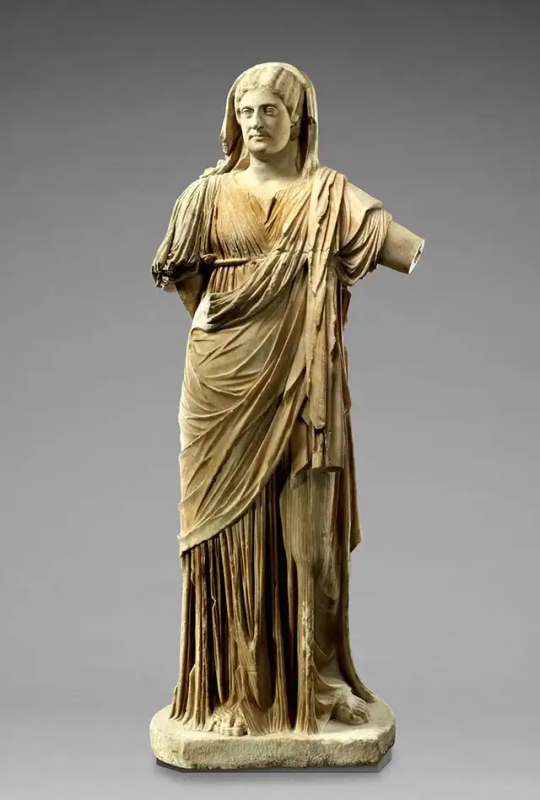
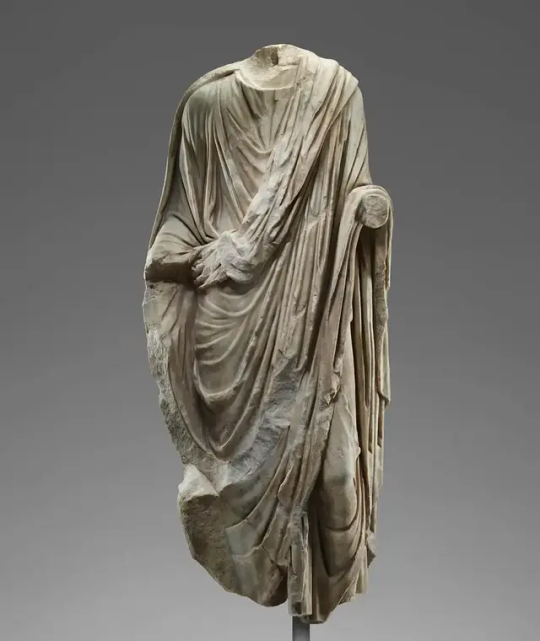
NOW! although the 6th-century Byzantine imperial costume boasts simplicity in silhouette, draping, and cut, it is truly elevated by its lavish bejeweled and embellished details.
Take, for instance, Empress Theodora's state costume: a white stola adorned with intricate gold and jewel embellishments at the hem, a purple paludamentum heavily embroidered with a luxurious gold border, and a prominently jeweled collar crowning the cloak—an iconic symbol of Byzantine fashion. Completing her regal ensemble is a headdress with cascading ropes of pearls. Meanwhile, her ladies in waiting don similar attire, albeit with fewer embellishments.
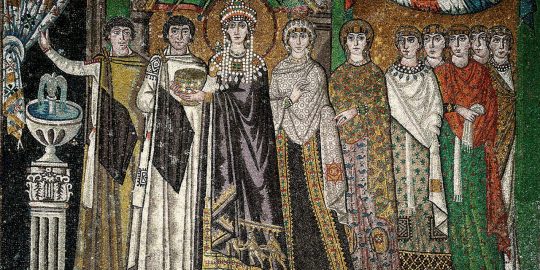
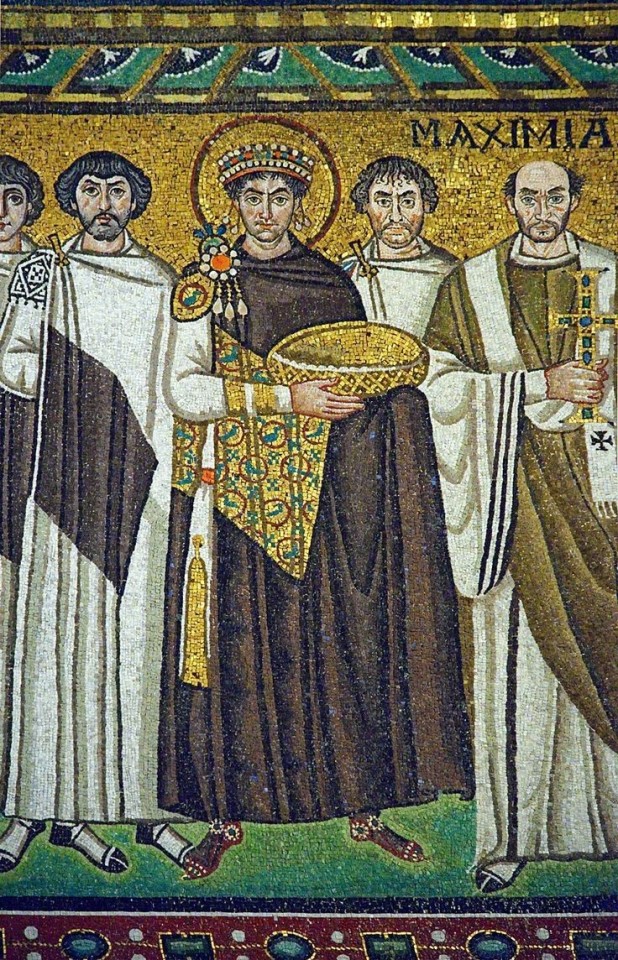

All in all, Byzantine fashion is all about garments embroidered with gold and adorned with pearls and jewels.
And it is this extravagant opulence I wanna see The Conquerors in - Aegon adorned in a blood-red paludamentum pinned gracefully on his right shoulder, while Visenya and Rhaenys don heavily bejeweled collars and intricate hairstyles.
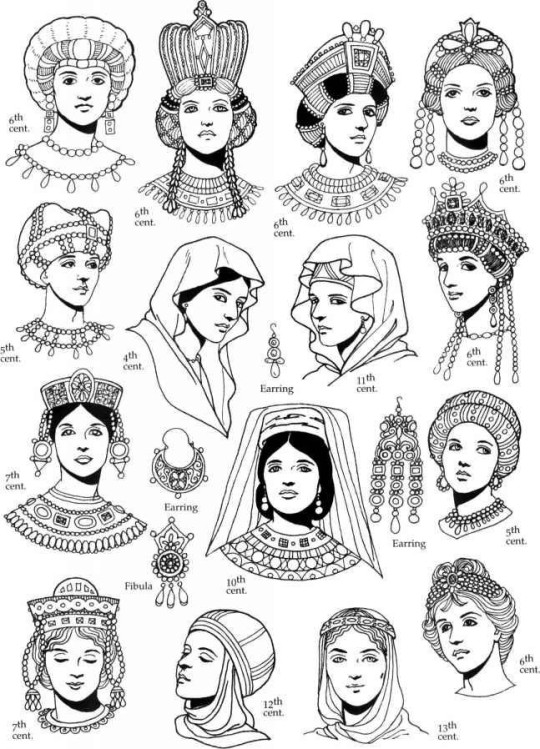
However, it doesn't have to be overly historically accurate. I believe that as long as certain 'iconic' Byzantine fashion elements are incorporated, the silhouette can be altered. Take, for example, the 19th-century depictions of Empress Theodora:
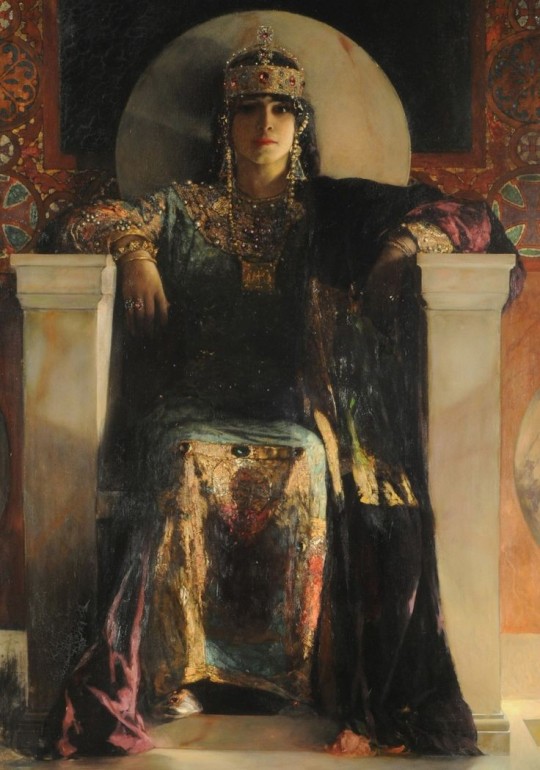
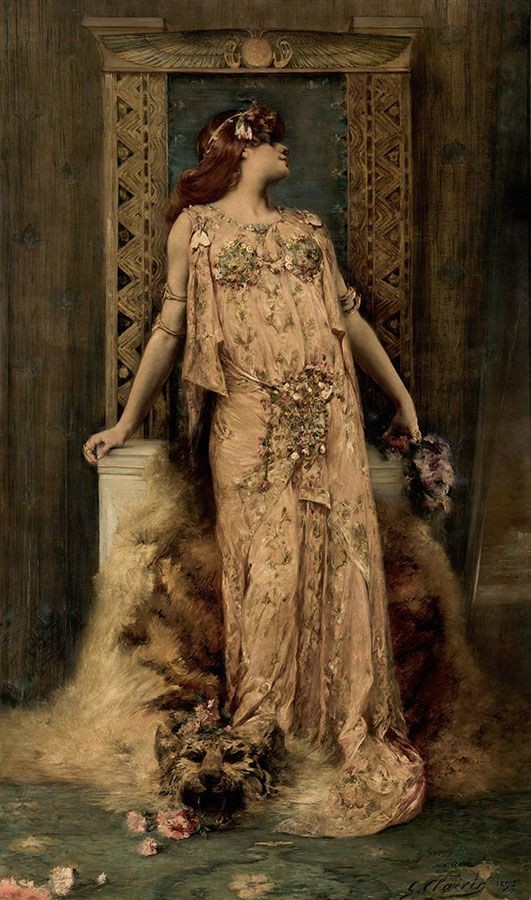
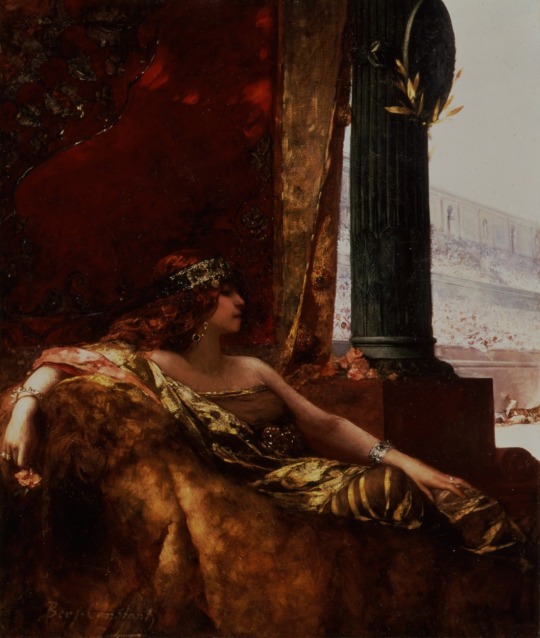

While most of them lack accuracy (with Jean-Joseph Benjamin-Constant's version being the closest to historical credibility), they successfully capture the essence of luxury, gold, and opulence.
Conclusion: I think if I were to draw The Conqueror sisters, I wouldn't necessarily adhere strictly to the historically accurate shapeless, modest silhouette. However, I would definitely strive to convey the essence of luxury and ornamentation in my depiction.
#The Conquerors#asoiaf#aegon the conqueror#visenya the conqueror#rhaenys the conqueror#fashion thoughts
290 notes
·
View notes
Text
Polish nobility is not something I'd approve of but dear God the fashion is amazing. I can't stop staring at all those men in 1670 and their hats and coats. I love the "orient meets eastern europe" vibe. And I love Zofia's conservative clothes, too. They're so dramatically sexy.
#i kinda regret that back then our nobility thought that fashion is for men to care about bc i love zofia's clothes but#i wish we'd get some super extra female costumes as well like the male oned#*ones#1670#1670 netflix#Period Drama#sansaorgana's shitpost
173 notes
·
View notes
Note
Forgotten Queen comes to see Nikola, Jack, and Raiden to see how things are liked for their time while wearing her more modest clothing yet it's revealing as she wore in her diplomatic meeting and battle as she show cleavage and back
And her son is with her both bio and adopted as they wear nice middle easterner clothing fit for a prince
With curiosity she asked if they show her what women wear in their time, and to say she looks good in anything in any time period of clothing
-It started off with a bit of curiosity, mainly due to the reactions of the three men that you have grown close with, who would always get a little flustered whenever they would see you in the clothes you wore.
-You didn’t see anything wrong with the clothes you were wearing, they were the same ones you always wore, but then again, you came from different cultures.
-Raiden didn’t mind your clothes, as he was rather perverted, but he was respectful towards you; Jack and Nikola were the shy boys.
-This is what made you curious about the fashion of women during their time when they were alive, and you reached out to them, inquiring about visiting to learn.
-This is what started your mini traveling tour, going to the different pantheons to visit your friends, and you were pleasantly surprised when you arrived at Raiden’s place to see Nikola and Jack waiting there as well.
-Your son and Zerofuku also came with you, both wearing clothes similar to your own, middle eastern attire, but of a time period they couldn’t exactly place.
-You had gained a lot of stares, as you were wearing a more modest outfit, the one you wore for formal meetings with other dignitaries, but your back was exposed and there was a long slit down your front, exposing your cleavage as well as slits in both sides of your dress, showing off your legs.
-Raiden had prepared a formal kimono, so you could inspect the different patterns and fabrics, which was enjoyable to you, but when some women entered, going to help you dress, you were a little more thrown off, “Are there always so many layers?”
-Raiden and the two women couldn’t help but laugh, finding it amusing as it did feel a little hard to walk around, you felt smothered, and you were stunned that many kimonos and women’s outfits had many more layers.
-When you walked out, you were surprised to see everyone else in men’s outfits, including your sons, who were running around, feeling much less hindered than you were.
-Your son was bright eyed looking up at you once you walked out, “You look so pretty mama!” you couldn’t help but smile before Raiden sent you a playful wink, “Y/N always looks pretty!” which earned him a warm smile from you.
-Jack went next and he prepared outfits for everyone, including your sons, who both commented that they felt weird being in suits, but they did like the capes. Raiden was also feeling a bit uncomfortable, as it was something he wasn’t used to.
-Jack had prepared an assistant to help you dress, mainly to help with the corset and the men couldn’t help but laugh when they heard you through the door, “I asked you to show me fashion, Jack, not torture me!”
-When you walked out, wearing a dress that fit your body very well, the corset laced tightly, the frilled skirts and the long sleeves of your dress, with lace and bows adorning you, you felt rather uncomfortable and very restricted, how were you supposed to fight in this?!
-Jack pecked the back of your hand, giving you a small smile, “You look lovely my dear.” You smiled softly at him and Zerofuku brought a matching parasol over for you, “Here mama!”
-Raiden and you both learned how you could fight in this outfit, when he made a comment, due to the bustle in your dress, about your butt looking bigger, and you whacked him over the head with your parasol, much to the amusement of the others.
-Nikola went last, and surprisingly, of the three, his was the most comfortable, it was still very modest and covering, with a high waisted skirt, a high collared top with long sleeves, but there was no corset and you felt like you could at least breathe.
-Nikola felt a bit shy, seeing you wearing the clothes of his own time, you looked stunning, and he managed to tell you that, while red faced, which made you smile warmly.
-Once back in your own dress, you couldn’t help but sigh softly, feeling less restricted and free.
-It had been a fun experience for you and your boys, seeing the different clothes from different cultures and time periods, but all in all, there’s nothing like the comforts of home.
78 notes
·
View notes
Text
So I was planning to do a post that said, "Fuck you! *medievals your Lawlight*" until I started researching how to dress them and make their hair look. My idea for L is that he had his hair cut into some kind of normal style at some point but let it grow way out into a big shaggy mess, and that he wears a mix of eastern and western clothing depending on comfort. For Light, however, things got tricky. All I could find for hairstyles and clothes were from the Edo period, when many men fashionably adopted the samurai hairstyle (shaved on top+man bun). However, that's a few centuries after what in going for, so I don't know if it was worn outside of the samurai class in the 14th century. In addition, I'm not sure if a 17-18 year old would have worn adult hairstyles and clothes or not. I found something about Wakashu, but a) it's kinda creepy and b) again, that's more 1600s-1700s.
So I guess what I'm asking is, History Side of Tumblr, what are some hairstyles and clothing styles worn by 14th century Japanese males in their late teens?
#Questions#History#Japanese history#Death note#Light yagami#L lawliet#Historical fashion#Japanese historical fashion#japanese fashion#Medieval Japan#feudal japan#ancient japan#japan#history side of tumblr
38 notes
·
View notes
Note
how do u design outfits? also, what are the nearby villages opinions on the clans?
Thank you for asking!!! Asks fuel my passion! Long post warning!
Outsiders
Instead of kittypets and rouges, we got the outsider settlements, which are just basically generic, 1800's European settlers and farmers.
The outsiders rarely interact with the clans outside of trading, seeing them as either savages or bandits- not helped by Bloodclan. When the clans were young, there were a lot of issues with fights breaking out between Thunderclan, Shadowclan, Skyclan, and these villages. The clans had a bad habit or raiding the villiages for and the villagers thought the clans were godless heathens. This reached its peak when once of the nearby villages had enough and burned down Skyclan's entire settlement and driving them out.
This being said, many outsiders do see the clans as being cool- afterall that's how we got our white boy Firestar!
Clan Fashion!

Thunderclan
their outfits are pretty medieval northern European and viking inspired. They raise sheep, so they get a lot of wool, which is both worn and traded. Warriors will often wear the pelts of the animals and monsters they kill for bragging rights. This makes them great for cold weather, but summers are rough. Jewelry is usually worn by women, but earrings are popular among men. Thunderclan clothes are not all that colorful because they have a higher need for camouflage. Thunderclan is, unfortunately, not the best with hygiene (stinky), but they are pretty good about taking care of their hair. Clan color is red and gold, which they wear red during clan gatherings and battles to distinguish the clan apart.
Windclan
Inspired vaguely by Eastern Asian Cultures - mostly Japan (I was a weeboo when I made this au, sorry). Since they have a lot more open land than the other clans, they invested in more farms over hunting, which has resulted in being able to get better clothing either through crafting or trade. They have a silk farm that produces good fabric for the clan, with the extra being traded to outsiders or in clan gatherings. This alos allowes their garments to be lightweight and easy to move in. They have very colorful clothes since they rely on stealth a lot less than others. Green is their clan color, so it the most popular. Hygiene is really important to them and hold spiritual significance (though this may be the medicine folks trying to get people to take better care of their bodies). Long hair is popular among older warriors, but younger, less experienced warriors are encouraged to keep it short because hair pulling is a classic shadowclan move.
Riverclan
Clothing is mostly Greek and Roman with a hint of Pacific islander for their tattoos and jewelry. Riverclaners spean 90% of their day in or around water, so they wear very little clothes in their daily life. Man rarely even wear shirts- showing off as much of their ceremonial warrior tattoos as possible. They don't have much room for growing cotton or raising animals, so they get most of that through trade (or stealing from Thunderclan). Jewelry is huge for both sexes.-both seen with some sort of colorful shell or shiny stone somewhere on their bodies. Their hygiene is okay... they wash often, but they always smell a little like seaweed or fish. Clan color is blue!
Shadowclan
Unlike the other clans, Shadowclan is not strongly linked to any specific culture. Instead, seeing as how they have a long history of letting in outsiders and they are seen as suspicious by the other clans, I made the pirate like! They wear pretty similar clothing to the outsiders that I've next door. Practical clothing is preferred to stylish stuff - if you wear jewelry flashy colors, they are gonna make fun of you. Most Shadowclaners keep their hair short because it is easier to keep the mud and bugs out. Women and medicine wear scarves or wraps over their hair for both religious reasons and to keep their hair from getting damaged. Hygiene wise, they are trying their best. Clan color is purple.
All clans wear custom cat masks for ceremony and battle
19 notes
·
View notes
Text
1920s
1920s Fashion

For our third fashion history lesson, we studied the 1920s and Art Deco. The 1920s was an incredible decade that changed fashion as we know it. Skirt lengths shortened and women were finally liberated from the dreaded corset. The silhouette became more rectangular, undergarments were abandoned and women showed no cleavage. However, the waist was still aparent at the start of the decade.
By 1923, the waist had dropped, women became more flat chested and embroydery was heavy and glamorous. Fabrics such as sheer and chiffron were used (see through fabrics).
La Garconne

French for the bachelor girl, this word was used as a derogatory word by the elderly and a complement by the young. It was used to describe rebellious, tom boys with short hair and who wore men's clothing. They took part in pre-marital sex and other 'rebellious' activities.
By 1924, trousers were boudoir attire. For example, Paul Poiret's satin pajamas.
During this time, women began to reapply their makeup in public. This wouldn't have been allowed 20 years prior.
Despite the liberation of the corset, some women still used them to make their busts look flat. This was achieved by the freedom corset.
Menswear

The Prince of Wales became the 'it boy' for men's fashion. He was an idol, making fair Isle knits fashionable, and others such as: loose fitting tailoring 'bum freezer'; white flannel trousers and blazers; checkards; stripes; plaid. In 1925, the Oxford stripes became the trending trousers type. Loose fitting that had an average size of 40 inches! Despite the change of fashion from formal to casual, evening wear for men was still black tie and tails.
Lucian Lelong 1889-1958

Known as the man who saved Paris, Lelong stopped Hitler from moving Haute Cauture to Germany during the Second World War. Born into a family of designers, Lelong started a fashion business. He was a very smart business acumen. Unfortunately, he had to go to war. But once the war was over, he came right back into the fashion business. His business flourished with 1200 staff. Lelong was influenced by sport, due to this his designed are associated with fluidity. His dressmaking became engineering; he was a great innovator. Not to mention his 40 fagrances.
He developed the talent of up and coming designers, for example, Christian Dior. And in 1948, after nearly 30 years, Lelong closed his house for good.
Jean Patou 1887-1936

Not only a business man but also a ladies man. The two things Patou loved was women and business. That much so, he opened a dress shop after the First World War. He named it the House of Patou and got his family to work for him. Patou was inspired alot by Russian and Eastern influence, including his love of fur. He brought mens fabric into womens sportswear; similar to Coco Chanel. Patou saw trends like cubism and art decor, so used these in his work. Jean Patou did many iconic and unique things, such as; the first person to brand his work; brought over American models to work for him; created the most expensive perfume at the time, using 10600 jasmine flowers and 336 roses; created mens silk ties from biased cutting waste.
Gabrielle Bonheur Chanel (Coco Chanel) 1882-1971

Chanel did not start off wealthy, she was poor and didn't like her background. However, she lived a good life, despite the fact her mum died when she was 6. She lived and grew up in a nunnery making hats. Chanel was the first designer to create womens jersey taken from men's underwear. She paved her way into fashion by using sex and her sexuality. Her house was established at 31 ru cambon in 1909. At the time, Chanel No.5 was one of the best selling fragrances in the world! And the interlocking 'C's are the most famous fashion logo.
Art Deco

The Art Deco period is a movement in the decorative arts and architecture, originating in the 1920s in France after the First World War. It was developed into a major style in western Europe and United States during the 1930s. It was graphic, strong patterning with rich Egyptian colours; exoctic. For example:

Hoover factory, London 1932-1935

Chrysler building NYC.
An example of an Art Deco artist was Charles Rennie Mackintosh.

#fashion#art deco#1920s fashion#1920s#chanel#charles rennie mackintosh#history#fashion history#historical fashion
15 notes
·
View notes
Note
15-lizards, I'm in love with your fashion posts. I devour each one you grace us with. Do you have any thoughts on the fashion choices of the far eastern reaches of Planetos, specifically the fortress cities of Kayakayanaya, Samyriana, and Bayasabhad at the fringe of the Bone Mountains in Essos?
Ooh yes I wish there was more lore on them


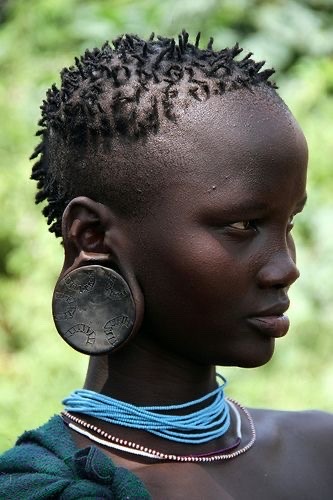
Obviously they have the rubies in their cheeks and iron bars in their nipples, so I think that’s kind of a testament to the amount of pain these warrior women can handle. They might stretch their ears as well, the bigger the lobe the more respected one is on the battlefield (like Dothraki braids but hardcore) and maybe the men have special piercings too, like the chosen men for procreation may have wooden spikes through their noses and lips to signal that they aren’t eunuchs
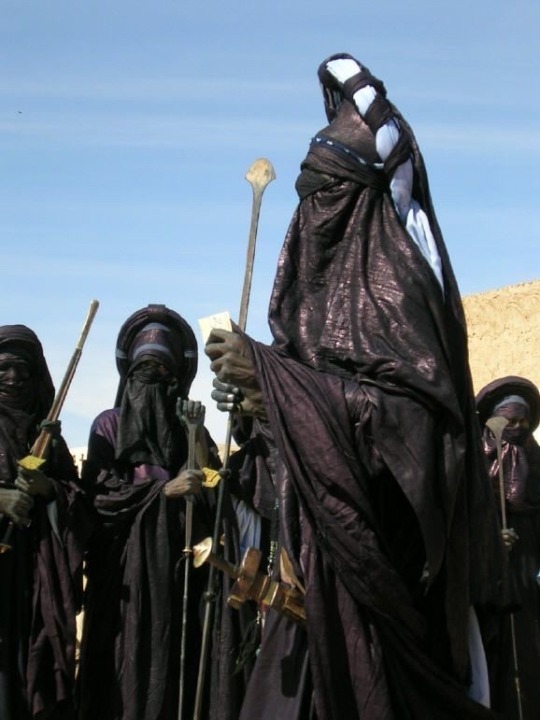


I’m of the mind that this is a society where “traditional” gender roles are mostly flipped, and so I think that the eunuch men are covered up so as not to signal that they are one of the rare men who has not been castrated. Obviously they have rankings among themselves, with different colors and wrap styles for priests, scholars, and servants. Only the men who have not been castrated are allowed to be without heavy facial coverings without it being seen as taboo

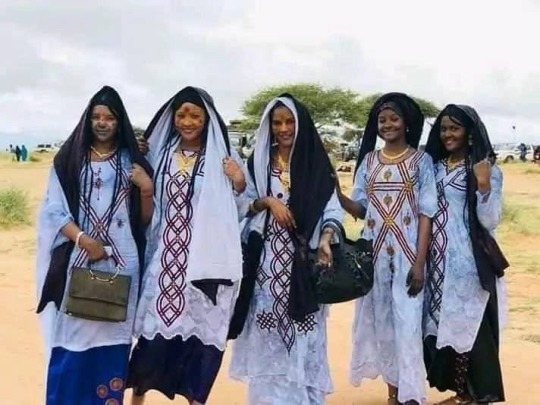
The women wear more practical clothing than the men, since they need to move around more. Basic linen gowns or other lightweight materials with colors and symbols that denote both class and experience on the battlefield. Higher status women wear more jewelry and softer fabrics, but no matter the status women probably wear clothes that can be tied back and fought in if the occasion arises


I think the women also wear their hair and makeup in a way that denotes status and experience, like their piercings. Perhaps Dothraki braids influenced their culture in some form, and a girl is considered a woman when she gets her first braid. Ceremonial face paint may also be used to show off a variety of things, such as familial lineage, the number of kills she has achieved, and what her status is
#asoiaf#asoiaf hair and clothing#hi I wished George talked ab the far East cultures more#I want more on the matriarchal Amazonian bone mountains
71 notes
·
View notes
Text
LoZ - Hyrulean Cultural Aesthetics
Important to note, Hylians, Sheikah, Gerudo, & Lupáns are all considered human.
Those with pointed ears are referred to as Cuspan & those without are called Ovelian.
Overall Cultural Influences:
Central Hyrule & Hylians specifically = Medieval Germanic & Arthurian English with some variation depending on location. All Hylian towns will likely have a little bit of this in them.
Ovelians = Rural, small town, down home, farmer, tough as nails, survivor, rough around the edges, traditional, conservative, but still rebellious, & generally very good-hearted. That means they are the rednecks, the cowboys, the military men, the American Southerners, the Vikings, & the Celts kind of characters. You're salt of the earth types. At least in feel, though not necessarily in culture. It's because of this that humans generally get along well with Gorons. Either way, humans stick mostly to the agricultural & ranching settlements for the most part.
Zora = Hard to tell as they generally don't wear clothing, but they do wear a lot of jewelry. If I had to give them clothes, I'd definitely say they'd be something flowy. Possibly Roman or Greek in fashion to go with the water theme? As for sensibilities, maybe a bit of French Rococo. I also get the impression that the Zora's Domain is actually divided into 2 levels: the Upper Domain & the Lower Domain. The Upper Domain is what we see in the games & consists of the commercial district & palace. The Lower Domain is entirely underwater & is where the Zora actually live. The reason we don't see it is because Link can't dive.
Rito = Northern Native American. Aldean specifically. Maybe a bit of Latin American.
Goron = A mix of Maori (Polynesian), African, Dwarven, & maybe a bit of Old West mining town, though it's hard to tell for certain as they generally don't wear clothing. At the same time, their general architecture seems to have a Town of Bedrock-type feel to it. Definitely something with a decent source of friendly machismo (not what is considered "toxic masculinity;" actual machismo). Something masculine & tribal, but also community oriented & friendly.
Gerudo = Egyptian/Middle Eastern Amazons with some Orc influence. Possibly with some hints of Hindu too. At least as far as fashion goes.
Korok/Kokiri = If Peter Pan & the Lost Boys were Hobbits.
Twili = Possibly Scandanavian? Also Chinese with some Japanese influences.
Mogma = They seem to be Brooklyn-ish. Maybe even a bit of an Italian-American Mob feel, but more so in the "friendly gangster" way. So, I'm seeing some Bensonhurst influences, which is a specifically Italian-American borough within Brooklyn, I believe. Maybe even a bit of New York Jewish? Like, they come across as being Italian mafia adjacent, but only in so much as the accent, the attitude, & family-oriented organization. Sort of an "it takes a village" & "we take care of our own" type of mentality. Not in any way actually mafia though & certainly not in the romanticized view of gangsters as I don't actually see the Mogmas being the types to actually commit crimes on the reg. And despite being avid treasure-hunters, they seem to have a general culture of altruistic generosity. By that, I mean that their love language is gift-giving.
Yeti = Norse Viking.
Minish = Borrowers.
Anouki = Inuit.
Lokomo = Possibly Greek?
Zonai = Mesoamerican.
*Búralupán = Gaelic, Celtic, & Nordic. (This is a race I made up, if you wanna know more, go to Wolf Link & the Lupán Race.)
Smaller Settlements:
Hateno = I'm getting Gaelic Scottish farming town. Also maybe a bit of Spain, Italy, & Greece. Mostly inhabited by humans, both Cuspan & Ovelian.
Kakariko = Japanese with maybe a touch of American Old West. While primarily Japanese, there's also some definite South Korean influences. Especially in their cooking.
Mabe = Rustic dairy ranching town vibes because I'm putting Lon Lon Ranch there. Based on how AoC & LA's Mabe was designed, their roofing is colorful terracotta tile & generally has ivy & such growing on their homes, so maybe Colonial Spanish. Mostly inhabited by humans.
Goponga = I'm getting rural Luisiana Bayou vibes, most likely due to it being located in a swamp. So, primarily Cajun, French, & Colonial Spanish with some Zora inspiration maybe. Mostly inhabited by humans & Zora.
Deya = Not sure yet, but I'm giving them a vineyard, peach orchard, & making them use them to make moscato, so maybe an old Tuscany winery & fishing village? Mostly inhabited by humans. From what we see in the games, it was actually the biggest settlement in Hyrule besides Castle Town, so it could've been a full-on town or city.
Ordon = Has a rural ranching feel & might be inspired by a southern agricultural town in Italy called Ordona. So, maybe rural Italy with American South mannerisms & sensibilities. Culturally, though, I get Gaelic Irish vibes. It might be the smials… Also, maybe a little bit of Welsh too. Either way, it's mostly inhabited by Ovelians & Lupáns (more Ovelian than Lupáns) with the occasional Hylian, Sheikah, & 1 or 2 Gerudo. (For more of their overall culture, go to Ordonian Culture & Ordon Cooking Culture.)
Lurelin = Rural Hawaiian fishing village. Maybe a little bit of Caribbean & Okinawan? With a little bit of Mesoamerican mixed in due to Zonai influence from the nearby ruins.
Ealiyah = Tibetan-flavored Gerudo farming & brewing town. Maybe a little bit of Russian & hints of Norse too? Also, interior decoration is eclectic & cluttered but cozy & colorful in a vibrant, rustic Bohemian sort of way. There are also some influences from humans, including Ovelians, Hylians, Lupàns, & even Sheikah to a degree as several of each race lives there too (all men), but overall, the culture remains mostly that Tibetan-Gerudo sort of style. They do a lot of weaving & sewing as well as dying. (This is a town I made up, for more on its culture & history, go to Ealiyah Town & the Highlands Gerudo.)
- Hànmalàn Hamlet = A small majority Upper Middle Eastern/Southeast Asian-flavored Gerudo settlement in the Faron Jungle with some Lurelinites & a number of Sheikah living there as well. Located in Damel Forest.
Tabantha Village = Norse with Rito, Yeti, & Lupán inspiration. So, old Norse Viking, Aldean, Celtic, & Gaelic with a Russian & Welsh accent. They use a lot of furs in their clothing. Mostly inhabited by Ovelians, Hylians, Rito, Yeti, & Lupán.
Shadow Hamlet = Dwarven possibly, with Goron inspiration. So, very masculine. Maybe a bit of Old Western Mining Town. A mix of Gorons, Hylians, & Ovelians tend to live here.
Koholint Domain = This is on the Koholina Archipelago, which Eventide Island is the smallest island of & will eventually become a fishing & port town. In-world, it has influence from Zora, Rito, & Lurelin. But, from a real world perspective, it's mostly Polynesian, coastal Native American, & coastal Hindu with some ancient coastal Greco-Roman (even Atlantis-like) influence for the underwater sections of the settlement. As well as in their formal fashion. There would likely be a tiny bit of Carribean & Okinawan influence in there too. The population is made up of Euryhaline Zora (able to survive in both salt & fresh water), Coastal Rito, & Lurelin humans. And, much like with how I think the Zora's Domain is built, the settlement's commercial district is on land, while the Zora residential area is underwater. The Rito & human residences, as well as the Cheiftain's home, are also on land. (For more on the specifics of this, go to Euryhaline Zora & Coastal Rito Port Town.)
Gatepost, Outpost, & East Post = These are all a package deal. These are mostly military towns, so that'll definitely factor in. They are positioned in such a way as to protect Oldcastle. Mostly inhabited by Hyrulean Humans, but with smatterings of the other races too.
Oldcastle = The site of OoT's Castle Town, a.k.a. the Great Plateau, so there'll be some DEEP historical significance going on. As such, it's mostly Medieval Germanic & Arthurian English. Mostly inhabited by Hyrulean Humans.
LoZ Cultural Masterlist
29 notes
·
View notes
Note
You asked about Númenor clothing and I have quite, uh, detailed headcanons about this!
I imagine Númenorean fashion as late Eastern Roman Empire, evolving toward late Byzantine clothing by the time of LotR bc hey, why not. Anyways, picture loose garments with rich woven trims, draped cloaks and super blingy belts and jewellery. Here’s how Wikipedia describes men’s clothing but if you want more in-depth infos check other sources
And here’s the links to a few pictures so you can have an idea!
https://en.m.wikipedia.org/wiki/Clothing_in_ancient_Rome
https://en.m.wikipedia.org/wiki/File:Aristides_med_himation_%C3%B6ver_chiton,_Nordisk_familjebok.png
https://en.m.wikipedia.org/wiki/File:Paenula_(image_from_page_867_of_%22A_dictionary_of_Greek_and_Roman_antiquities..%22_1849).jpg
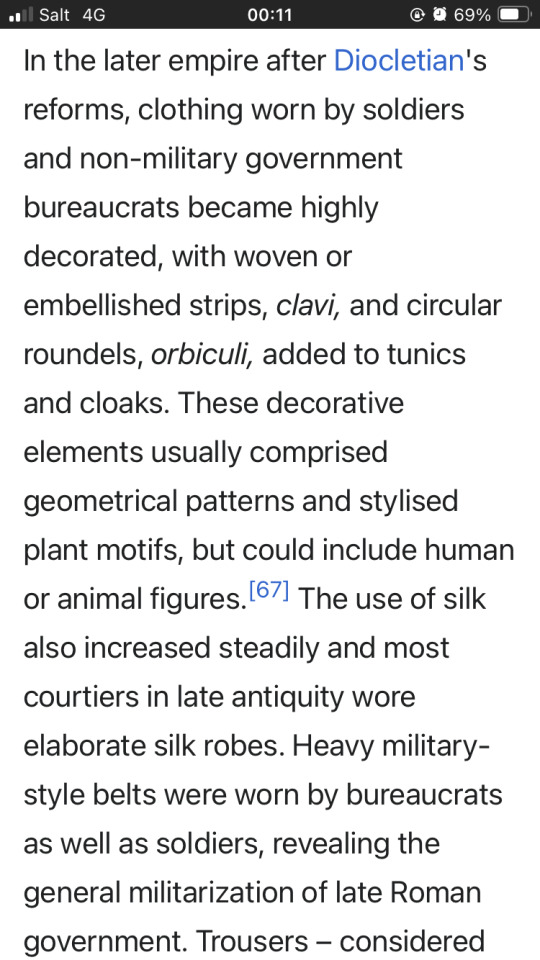

ADAHUWGRYUAW THANK YOU!!!!!!!!
Don´t mind me spending my night researching this!!
I always like Numenor with patterns so this already fits perfect!!!
7 notes
·
View notes
Photo
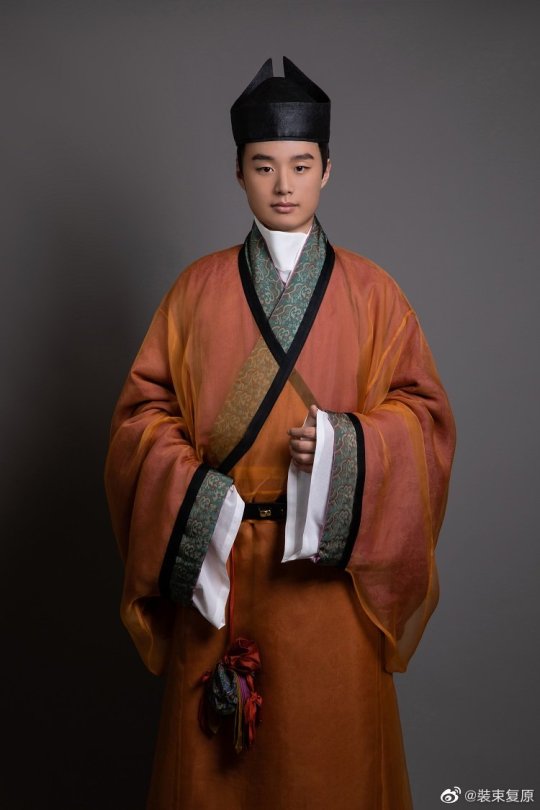

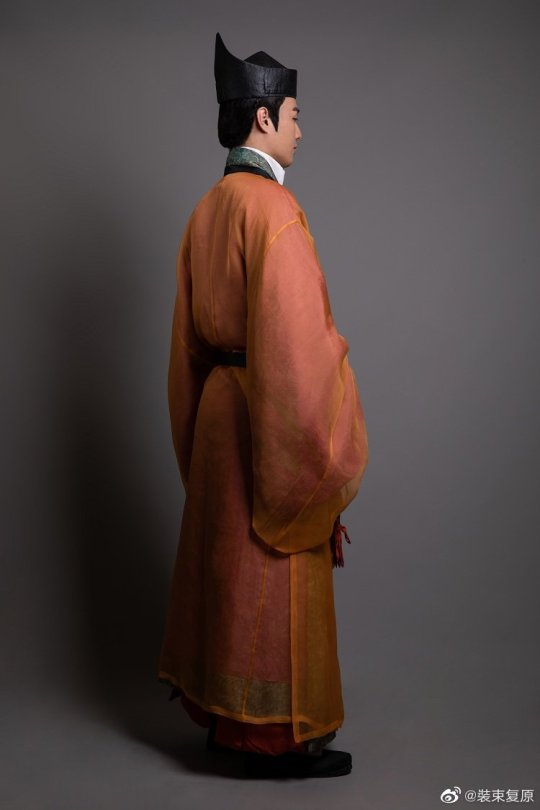
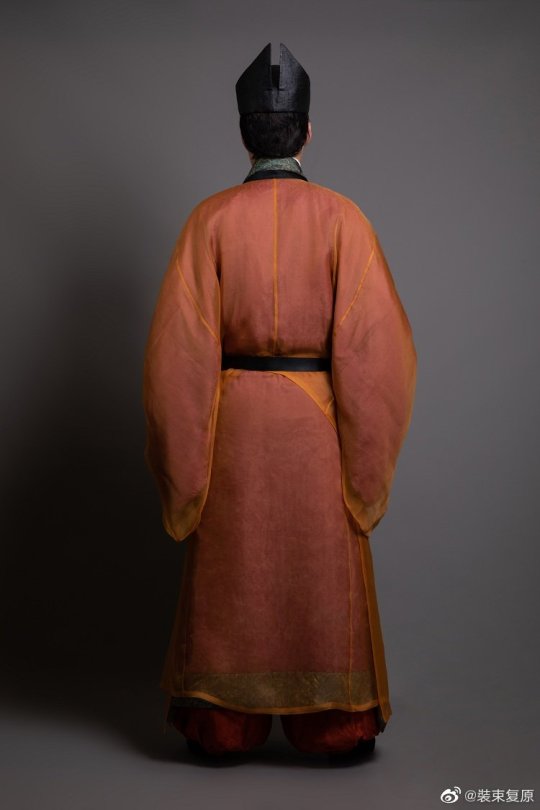
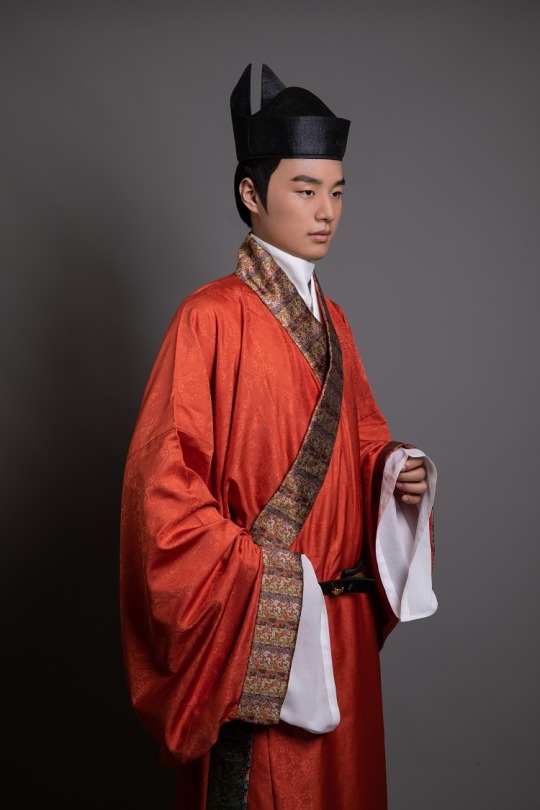
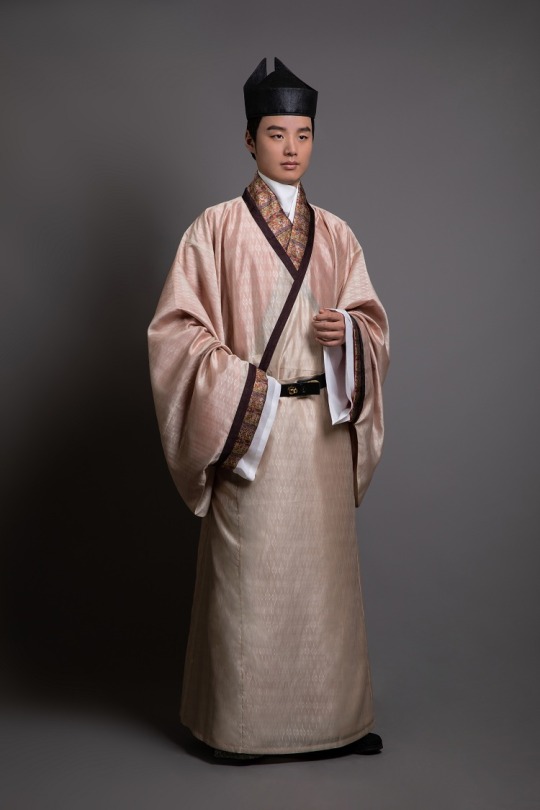
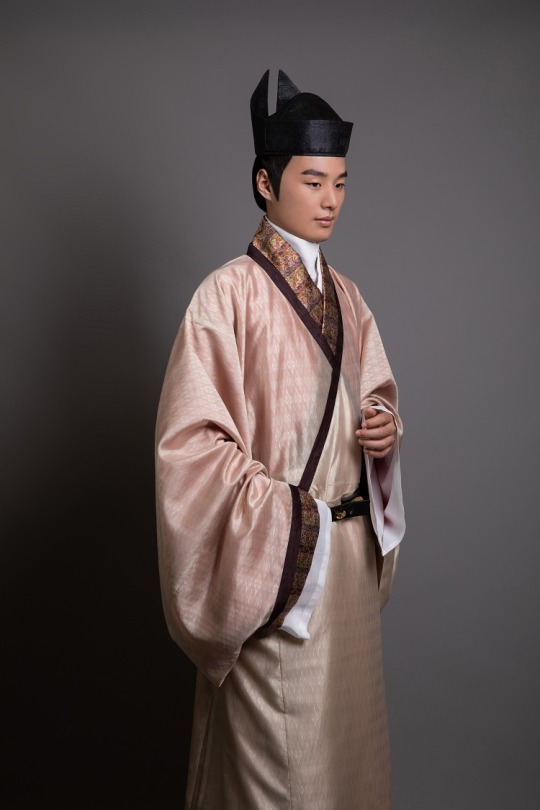


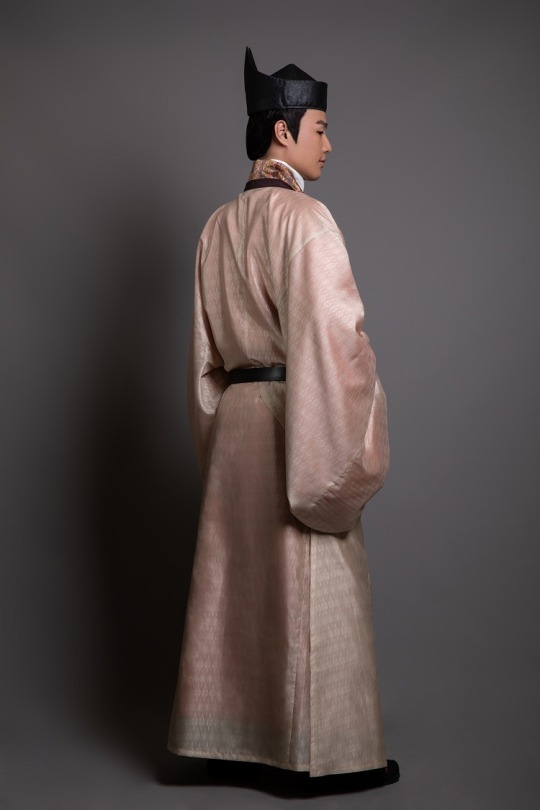
【Historical Artifacts Reference 】:
China Eastern Han Dynasty Playing Qin Pottery Figurine
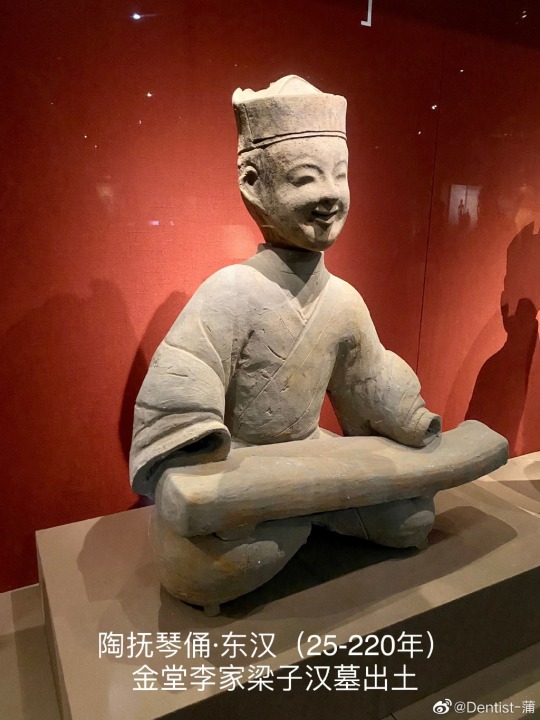
China Eastern Han Dynasty Playing the Dizi(Chinese flute) Pottery Figurine
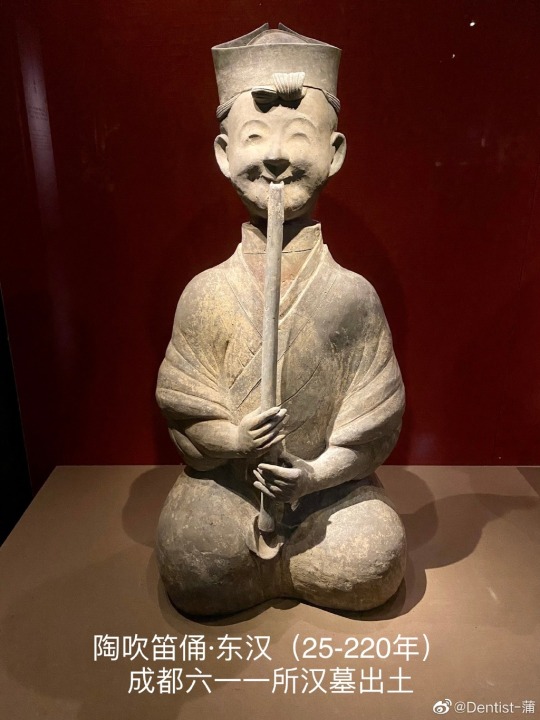
China Wei and Jin Dynasties "person who conveys official documents and letters" Mural Bricks
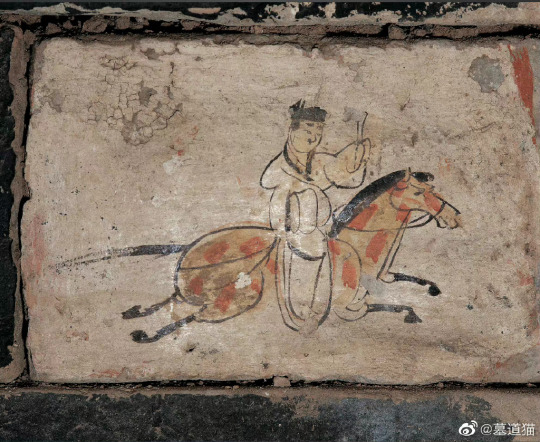
[Hanfu・漢服]Chinese Eastern Han Dynasty (25–220 A.D.) Traditional Clothing Hanfu & Headwear
—–
【History Note】
During the Eastern Han Dynasty, men's attire was usually wider than the Western Han Dynasty period, which was more convenient for activities.The collocation of wearing Jie Zhi(介帻) and straight train robes(直裾袍服) is favored by scholars at the time.
This set of attire for the scholars/literati of the Eastern Han Dynasty is wearing a Jie Zhi /介帻 on head, with a purple brocade border cotton robe, red silk cotton trousers, waering a yellow gauze on the outermost layer, and a brocade pouch around the waist.
At the time, the fashion of wearing gauze robe was still popular, which looked elegant and dignified, without losing the beauty of agility and elegance.
This set of attire has existed among the literati until the Wei and Jin Dynasties.
————————
📝Recreation Work : @裝束复原
👗 Hanfu: @桑纈
🔗Weibo:https://weibo.com/1656910125/MdvaOoRei
————————
#Chinese Hanfu#Eastern Han Dynasty (25–220 A.D.)#hanfu#hanfu history#hanfu accessories#chinese traditional clothing#chinese historical fashion#chinese history#Chinese Costume#chinese costume history#Chinese Culture#artifacts#Wei and Jin Dynasties#裝束复原#桑纈#漢服#汉服#Jie Zhi(介帻)#直裾袍服
135 notes
·
View notes
Text

This is an index of the many, many guides created by the Fountain Of Knowledge also widely known as @inky-duchess. However I decided to organize and revise to share, after seeing one ask about whether or not there was a compilation.
Also, I had to breakdown the list over multiple posts due to Tumblr's constraints, so I have added a handy list with each part.
Table of Contents
Part One Part Two ⬅ You Are Here Part Three
Character Creation
Appearance - Character Traits - Unlikeable Characters
Clothing & Accessories
Jewels Tiaras Part 1 - Tiaras Part 2 - Jewellery - Coronet Beauty Hair - Cosmetics & Makeup Men Headwear - Fashion - Clothes - Uniforms Women Headdresses Part 1 - Headdresses Part 2 - Headwear - Gowns General Dressing Your Monarch - The Suit - Footwear - Peasant Clothes Clothes By Era Regency Fashion - Renaissance Gowns - Victorian Fashion - Edwardian Fashion Clothes By Culture Middle Eastern - Celt - Native American/Indigenous - African Traditional - Asian Traditional - Russian Court Gowns
Writing People
Kings - Queens - Princes - Princesses - Male Consorts Heirs & Spares - Mistresses - Bastards - Ladies In Waiting Ambassadors - Wards & Fostering - Servants - Royal Guards
Court and Courtiers
Surviving Fun & Games Male Court Positions Part 2 Female Court Positions Monarch's Council What Nobles Do
Big Happy(?) Family
Writing a Royal Family Part 2 Ottoman Harem Great Houses (19th-20th Century) Russian Nobility Medieval Household
Etiquette
Courting - How To Dress - Balls - Tea - A Day At Court - Court Etiquette
A Day In The Life Of...
Royalty - Queens - Princesses - Noble Ladies - Courtiers
How to be Social
Tis The Season Debutante Ball Balls Hosting a Society Dinner Food & Drink Letters & Correspondence Going Hunting Gestures
Court Archetypes
The Good King The Bad King The Good Queen The Bad Queen The Princess The Prince The Male Mistress The Advisor The Mentor The Pretender The Dynasty The Dethroned Royals The Courtiers Ladies-In-Waiting
17 notes
·
View notes
Text
@brittunculii sent: setting prompts: within a quiet corridor of a castle during a lavish ball - historical, for Arthur !
As much as João could not stand king Charles II, there was a certain affection he held for his wife that drew him to this party with little complaints. Not to mention, João rarely turned down any opportunity to go to sea, and similarly to this, rarely denied himself the chance to sail to England.
He's worn his finest: deep green, silver silk embroidery. While he knows that the darkened cloth is not the most fashionable in these parts, he's certainly one of the finest dressed of the upper class here, even in spite of this— a fact he can thank his eastern trade routes for. My, how the ladies of the ball fawned over him: his accent, his looks, his worldliness, his exotic flair to his outfits, his full luscious hair. João would die before he wore a wig, regardless of what the so-called 'fashion' said. Those men with wigs simply wanted what he had naturally.
What an utter menace João had been tonight as well. Giving and taking away in the same breath. He'd saved Charles earlier from the vulture-like women who'd been hounding him, but in the same breath he'd caused fury when he'd whispered to him an invitation to join him on the dancefloor, or perhaps later. He'd narrowly avoided a dagger to the gut, not that being stabbed would have done more than excite him.
Arthur too had not been spared, a night of stolen glances as he danced with woman after woman, had even reached across the Englishman on this last partner to connect his hand with hers, not without a subtle drag of his fingers across the other man's pale skin. It was calculated, something that could appear accidental to anyone but themselves, but infuriating when he then flits away with yet another beautiful noble.
It doesn't escape his notice when Arthur slips away from the ballroom, and with this last dance, João excuses himself from his latest dance partner with a dip of his upper body, and a kiss to her knuckles.
An utter gentleman he'd been— though surely the two Englishmen would have spat at the rest of the room's agreement on such a statement, and with good reason (João however would vehemently deny such arguments against his character. He had and was a gentleman, the other two were simply jealous.)
He takes a glass of wine from a passing servant, sucking the liquid down in one breath and setting it back atop the serving tray before he exits swiftly from the room, the direction he'd watched Arthur slink out of earlier; with his twisted expression and tight shoulders. Perhaps he had been pushing things just a smidge too far, teasing him all night, spending most of the evening on the dance floor with only the most beautiful of the women. He'd been quite inattentive to his host in every regard other than perhaps his eyes— deep hazel gaze consistently drawn back to the Englishman over the heads and shoulders of others.
It doesn't take him very long to find the other man, tucked away in this small corner of the castle's labyrinth-like halls. Here it is quiet, the party laughter and chatter a soft buzz and the music muffled and gentle. He leans against the cavernous open doorway, ankle hooking his other as he leans his shoulder against the cool stone, eyes taking in his form. He looks quite relaxed, almost sleepy, but they both know it to only be a rouse. That in spite of this lax exterior, he would be ready to move in a moments notice_ not that he thought himself in need of such a thing.
"Boa noite," he greets lowly, a slow grin spreading across his face like a wild fox, sly and calculating. "Have you been waiting for me for long?" The deep baritone is practically purred to him, though João is accurately aware of how long he'd been here his long dark lashes bat slowly at the blonde, as the woman had been doing to João all night— yet there's no denying that this was the most interest he'd genuinely showed in anyone all night.
4 notes
·
View notes
Text
Royal Court Fashion
Specialist Edition: Nabu

It is very fitting Nabu wears purple, as he is my KING!
Why I am doing this bc they need more outfits besides their bodysuit. And I want justice for my Winx Club Babies for a real-life design.
I tried to find outfits according to cultural Background. I researched, and Nabu is claimed to be Mesopotamia inspired. At least that was on a wiki page from winx Club. But then I also saw people saying he has an African or Indian background. So, I am unsure. I thought he was Arabic. Let me know what you think.
Please let me know your opiniononr traditional clothing from the country you think he was inspired from.
Name origion:
that could give further hints to his cultural background.
The alias name he used Ophir:
"...mentioned in the Bible, Ophir. The real location of Ophir is unknown, and there is speculation it was in Africa or South America or India" - Winx Club Wiki
The name Nabu comes from Babylonian mythology. Babylon or Bable is said to have been one of the most important cities in the old days. It is claimed to be in today's Irak.
Description:
Nabu is described as having a "tan complexion with very long brown hair." -Winx Wiki. In comparison, Aisha/Layla is described as "Aisha is a dark-skinned girl". Therefore, clearly states that she is black while Nabu is described as tan. Therefore, one can make the point that he is Asian either of Iraqi or Indian background.
Another example would be Flora. She is described as: " Flora is a young tan-skinned girl." (Same as Nabu.) Flora is modeled after Jennifer Lopez. Therefore, is Latina.
Overall, I would argue Nabu is of Arabic background.
*reference winx club wiki
Outfit description:
He wears a purple tunic with gold lining and a long braided ponytail. Winx wiki describes his outfit:
"In Season 3 and the beginning of Season 4, his clothing bears a close resemblance to traditional Chinese clothing but lacked the silky designs."
- Winx Wiki

Therefore, I would argue that Nabu is Asian. I'm leaning more toward having an Arabic background. I settled, therefore, on Irak.
I tried to find appropriate clothes but I am not familiar with the traditional clothing of Iraqi men. I researched it said:
"The costume for men consists of a pair of baggy pants known as a shalwar, a long-sleeved shirt, and a vest. "
- What modern Iraqi people wear. Talk in Arabic
I googled Shalwar and long-sleeved shirt and west in hopes of finding appropriate outfits. I am not sure if this is 100% accurate as this is not my culture. I liked the outfits and thought it would be interesting to see Nabu wear something like that. Please let me know if you have more knowledge or more appropriate clothing ideas.
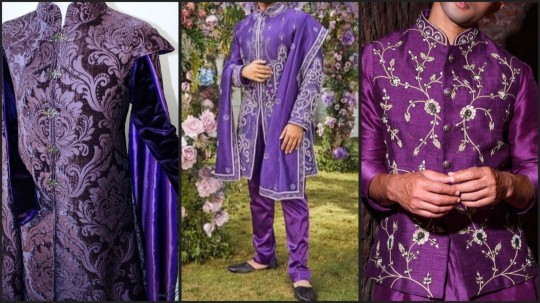
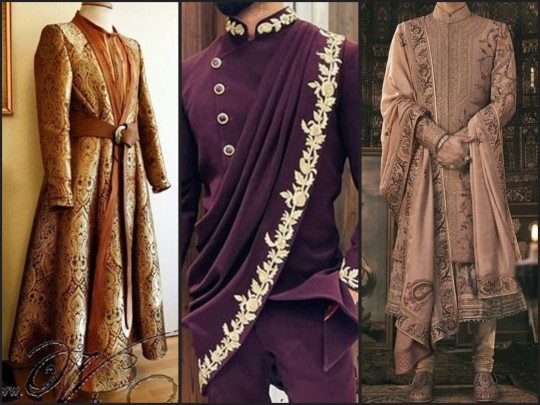
The Design:
These outfits are worn on formal events like Stella's princessball. Attending Royal Court in Eraklyon. Formal dances thrown by the three schools.
More casual going out fashion



They are worn when they are on earth and somewhat try to blend in while still keeping their own touch, such as wearing the color purple or Middle Eastern shoe wears and more baggy pants.
I think Nabu would still keep his streamlined outfits. With a simple shirt and a jacket or vest above that can be opened at the front. So, it flows in a straight horizontal line. His pants also would not be too tight so he could move around and be more free.
A sweet headcanon I have is Layla and Nabu doing each others hair as a form of bonding and love language. In the evening or morning, they take their time and braid or detangle their hair. They use that opportunity to talk about anything and nothing. In the morning, Nabu talks about his dreams and what they could mean, and in the evening, Layla would talk about the things she and Winx have done and her worries about what will happen.
It is the calmest time of the day for them. A time just for them and be with each other.

#winx club#winx#winx nabu#winx club nabu#winx redesign#winx fashion#winx club fashion#winx club layla#winx club season 2#winx club season 3#winx club season 4#winx club aisha#winx aisha#winx layla#winx club flora#winx flora#the specialists#the specialist#winx club specialist
40 notes
·
View notes